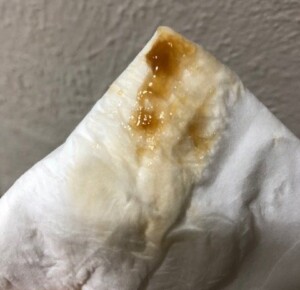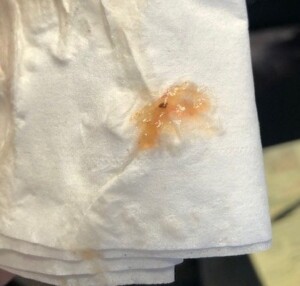Here’s my experience with postmenopausal blood tinged discharge and how, after a full workup, no cause was found.
One day when I wiped myself after urinating, I felt moisture on the palm of my hand as it came in contact with my pubic hair.
I saw a tiny amount of goldish goopy discharge on the toilet paper.
I then realized that drops of it were in my pubic hair, and gave myself a second wiping, pressing the tissue against my pubic hair.
It picked up what you see in the top image of this article: a goopy discharge, apparently from my vagina, with a trace amount of blood. The dark particle presumably was fecal matter from a previous bowel movement.
I could have taken the approach of “Wait and see if it happens again, and if so, make a doctor appointment.”
This approach would have created a ton of anxiety, as I’d be waiting for that shoe to drop for who knows how long, and during that interim, I’d also be wondering if anything sinister was growing inside me.
But it was a no-brainer. I immediately made an appointment with an OBGYN – but not my regular doctor, because she wasn’t available for another four weeks.
I was not going to walk out of that doctor’s appointment without an endometrial biopsy.
Twenty months prior, I’d had an endometrial biopsy after seeing a solid drop of blood on the tissue paper, but no real amount of goopy or mucous-like discharge with it.
Twenty months prior I had been diagnosed on the spot with an irritated urethral caruncle (caused by postmenopausal estrogen depletion), and the endo bio had been negative.
Nevertheless, I welcomed the second endo bio. The OBGYN gave me an internal pelvic exam and test for bacterial vaginosis: both negative.
I asked for a posterior vaginal Pap smear, but she said it wasn’t necessary. I didn’t like that response.
I also didn’t appreciate that she took my symptom (I had shown her the image) so lightly.
She downplayed it, saying, “There really isn’t that much blood.”
I found her approach alarming, because I’d read (prior to the appointment) in medical journals that ANY amount of visible blood is a red flag, and that a tinge of vaginal blood, or trace amount, is to be taken as seriously in postmenopause as is a more generous stain of pure blood.
She suspected vaginal atrophy as the cause of the mucous discharge.
I’d been using vaginal estrogen cream to prevent the yellowish discharge of postmenopausal vaginal atrophy.
Why would I then have discharge, especially since she said that my vaginal tissue did not appear friable (easily crumbled)?
She said that the atrophy could be taking place higher up, in the cervix or uterus.
I then wondered why the cream, which is supposed to have a local effect, did not prevent this alleged, higher-up atrophy.
A week after that appointment I had a second episode of gob-like vaginal discharge (see below).

The camera makes it look a few shades darker. This time, there was NO sign of blood.
The second endometrial biopsy was negative.
I was then NOT given a diagnosis. I was left in limbo.
I then contacted (via the HMO’s email messaging system) my regular OBGYN, with whom I have much better chemistry, and who comes across as a much more thorough, “talky” doctor.
She invited me to come in for a follow-up since I had so many questions.
Not only did she willingly perform the posterior vaginal smear, but she gave me (at my request) a digital exam via the anus.
I also got a second internal pelvic (digital) exam, plus an abbreviated transvaginal ultrasound (which I had not known was coming, but amazingly, she offered this right then and there in the office).

Probing tool for the transvaginal ultrasound. Shutterstock/Doro Guzenda
Everything was normal, including uterine lining measurements of one millimeter by 0.7 millimeters.
She suspected the blood tinged mucous had originated from my vagina rather than cervix or uterus.
She said that despite use of the vaginal cream, sometimes there can still be atrophy. She also said something very interesting:
In the case of unexplained postmenopausal discharge containing blood, the medical team’s job is to RULE OUT CANCER, rather than figure out the cause.
In fact, she wasn’t concerned with the cause, as long as all of these tests were ruling out cancer.
The only thing I’d have to wait on was the posterior vaginal Pap. A few weeks later the result was insufficient tissue to analyze. She told me to repeat this test in four months.
Four months later, she took two swabs, plus tossed in a cervical Pap smear, even though I wasn’t due for one in another year.
Three weeks later the results were negative.
Extreme Reassurance
• Two negative endometrial biopsies 20 months apart
• Normal transvaginal ultrasound; very thin endometrial lining
• Normal pelvic and anal digital exam
• Negative cervical and posterior vaginal Paps
• Normal-appearing visible exam
If you’re postmenopausal and experience an unexplained discharge of gobs from your vagina, especially with even just a tinge of blood – GET THE FULL BATTERY OF TESTS.
I had even gunned for a hysteroscopy, but both doctors turned that down, explaining that a negative endometrial biopsy alone would be very reassuring.
Urinary Tract Origin?
Soon after having seen the first doctor, I saw a urologist to inspect the previously diagnosed urethral caruncle, which the first OBGYN said didn’t appear to be the cause this time around.
The urologist said it was very tiny and didn’t think it was the cause. He inserted a catheter and extracted some urine for analysis. He said this procedure showed him that clinically, everything appeared normal.
The urinalysis was normal. He said that the blood tinged mucous, which I’d shown him an image of, did not have a urinary tract origin.
I did a TON of reading up in medical journals on postmenopausal vaginal discharge – namely all the possible causes (a LOT), and what tests a woman should undergo.
Let Me Sum It Up for You to Save You a Lot of Time
Ask your OBGYN about all of the following tests.
• Digital (doctor’s fingers) pelvic exam via vagina and anus
• Cervical Pap smear (if you’re due for one)
• Posterior vaginal Pap smear
• Transvaginal ultrasound (abdominal ultrasound isn’t as sensitive)
• Endometrial biopsy
• Some doctors favor a hysteroscopy over the endometrial biopsy.
• NOT ONE medical journal advised that a woman get ALL THREE tests: transvaginal ultrasound, endometrial biopsy and hysteroscopy.
It was always two of the three. Which two will vary from one OBGYN to the next.
Let your OBGYN guide you. But one thing is absolutely for sure, if you have postmenopausal vaginal discharge, even without blood: DO NOT IGNORE. DO NOT WAIT AND SEE. PROMPTLY MAKE AN APPOINTMENT.
An extra layer of reassurance would be a normal exam by a urologist.










































